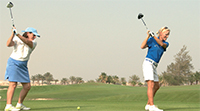Course management is important on any course, but here at the Royal Golf Club it is vital. There are a lot of sand areas and big drop-offs around the greens, which means if your ball ends up there, it could waste shots on the scorecard, writes Tim Backhouse – Royal Golf Club Head Teaching Professional.
Every shot needs to be thought about carefully, whether it is the tee shot on the first or the last putt on the 18th, they all count.
Obviously, everyone is different in terms of scoring. For example, a professional would be looking at pin location on a par 4 tee shot to determine where he wants to hit his drive to give him the best angle into the flag. For the average golfer I would recommend looking to see where the trouble may lie and the pros-and-cons of being aggressive. If there is out-of-bounds or any sort of hazard, look at the best way to miss them; maybe by hitting a 3 wood so that it is out-of-range or favouring the opposite side of the fairway to be safe. But once you have decided where you want to play your shot, you have to be focused on that point – don’t think ‘miss the pond’ but instead think ‘hit it at the tree in the distance’, for example, or ‘aim for the strip of grass in the fairway’. The smaller your target is, the better you become.
The most common fault I see when playing with amateur golfers is going for the ‘one-in-10 shot’. If the green is right on the limit of the ‘perfect’ shot and there is water or sand between you, the best option is probably to lay up away from the hazard and play a short wedge from there. This generally limits the big scores and also still gives you the chance of making par.
Hitting an approach to the green can also catch us out; sometimes it is better not to go straight for the flag.
If the flag is tucked into the left side of the green then aiming 5 yards right of the flag is a good option, as this gives you some margin for error. If you pull your approach shot it lands next to the hole, hit it straight and you have a 15 foot putt and if you push it to the right you have a long putt or a chip with lots of green to work with. Also, take note of where the slopes are on the course - if there is a big slope to the left of the flag that may help draw the ball closer, it can be used to your advantage and on the same note, if the slope is running away from the flag, it is worth aiming slightly to the other side of the flag.
On the putting green make sure you decide where you’re aiming before you set up to the ball – be very precise with your alignment, i.e. if there is just a little break to the putt, pick a point slightly off centre at the back of the hole and if there is a big break, still pick a point, maybe a leaf or a playing partner’s ball marker. Then the target you have decided should be the last thing that you look at before you look back at the ball.










